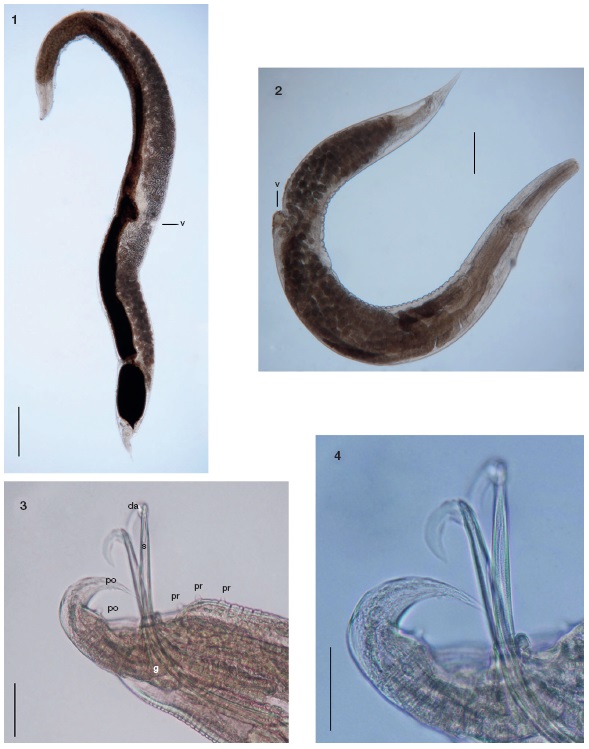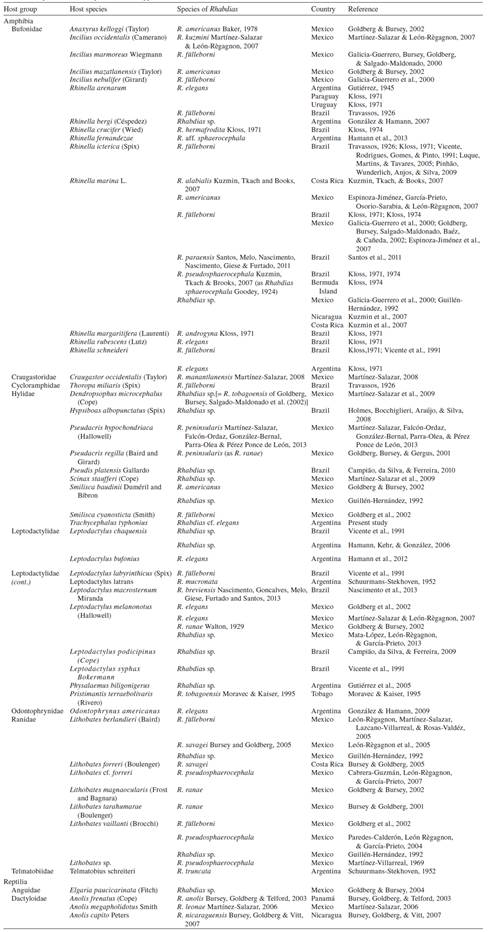The veined tree frog or common milk frog, Trachycephalus typhonius (Linnaeus, 1758) (Anura: Hylidae), is a very widespread frog from the lowlands of tropical Mexico, Central America (to 2,500 m asl in Guatemala), to Amazon Basin of Colombia, Ecuador, Peru, Venezuela, and Brazil, Guianas, and south to Brazil, Paraguay and northern Argentina (Frost, 2014; Soares, Iop, & Santos, 2012). In Argentina, this anuran species is distributed in Corrientes, Chaco, Entre Ríos, Formosa, Jujuy, Misiones, Salta, Santiago del Estero and Santa Fe Provinces (SIB, 2014). The veined tree frog is a nocturnal amphibian typically found perching on tree branches and vegetation while foraging at night. It preys on spiders, insects and bats, having a generalist diet (Duré & Kehr, 2006).
The helminth fauna of T. typhonius has been poorly studied, so far 6 species of helminths have been recorded parasitizing this species (cited as Phrynohyas venulosa and Trachycephalus venulosus ): Polystoma lopezromani Combes and Laurent, 1979 (Monogenea: Polystomatidae) from Argentina (Combes & Laurent, 1979); Batracholandros spectatus (Freitas and Ibáñez, 1962) Freitas and Ibáñez, 1965 (Nematoda: Pharyngodonidae), and larvae of Physaloptera sp. (Nematoda: Physalopteridae) from Peru (Bursey, Goldberg, & Parmalee, 2001); and Parapharyngodon duniae Bursey and Brooks, 2004 (Nematoda: Pharyngodonidae), Aplectana incerta Caballero, 1949 and Aplectana itzocanensis Bravo-Hollis, 1943 (Nematoda: Cosmocercidae) from Costa Rica (Bursey & Brooks, 2004, 2010). The aim of this paper is to increase the knowledge of the diversity of helminth parasites from anurans from northeastern Argentina.
On September 17th 2012, 2 specimens of T. typhonius were collected at La Marcela farm in Pirané, Formosa Province, Argentina (26°17'35" S, 59°08'38" W), with authorization of Ministerio de la Producción y Ambiente, Dirección de Fauna y Parques of Formosa Province. The frogs were dissected after an overdose with 20% benzocaine and all organs were examined using a Stemi 2000-C Zeiss stereoscope. The collected nematodes were counted and fixed in 5% formaline and cleared in Aman's lactophenol for light microscopic investigation, using a Standard 25 Zeiss optical microscope. For their identification were used taxonomic descriptions taken from specific literature (Anderson & Bain, 1982; Baker & Vaucher, 1986; González, Quiroga, Moreno, & Sanabria, 2013; Gutiérrez, 1945). All measurements are given in micrometres (μm) unless otherwise stated, as the range followed by the mean and standard deviation in parentheses. The nematodes were deposited in the Helminthological Collection of the Museo de La Plata (MLP), and the hosts in the Herpetological Collection of the Museo de La Plata, La Plata, Argentina (accession numbers: MLP A5642, MLP A5643).
Rhabdiasidae Railliet, 1915
Rhabdias Stiles and Hassall, 1905
Rhabdias cf. elegans Gutiérrez, 1945 (Fig. 1)

Figure 1-4 Nematodes from Trachycephalus typhonius. 1. Rhabdias cf. elegans, hermaphrodite gravid specimen. Scale bar= 500 μm. 2. Aplectana hylambatis, female, entire worm. Scale bar= 200 μm. 3. Aplectana hylambatis, male, posterior extremity. Scale bar= 50 μm. 4. Aplectana hylambatis, male, enlarged view of the distal articulation of spicules. Scale bar= 50 μm. Abbreviations: da, distal articulation of the spicules; g, gubernaculum; po, postcloacal papillae; pr, precloacal papillae; s, spicules; v, vulva.
Host: Trachycephalus typhonius (L.) (Anura: Hylidae).
New host record
Site of infection: lungs.
Prevalence and intensity of infection: 50% (1 of 2); 2.
Voucher specimens deposited: MLP-He 6792.
Description
(Based on 2 hermaphrodite gravid specimens). Body cylindrical. Body length 5.9-6.4 (6.1±0.38) mm, maximum width 0.43-0.46 (0.44±0.02) mm. Anterior end rounded, posterior end conical. Body cuticle swollen, with irregular folds. Oral opening narrow, without labial structures. Buccal capsule infundibuliform, with sclerotized walls, 12-19 (15.6±5.3) deep, 16.5-19 (17.7±1.8) wide. Esophagus small, cylindrical, with a posterior dilatation. Esophagus length, 369-391 (380±15.71), 6-6.2 (6.1)% of the body length. Esophagus width 45-57 (51±8.32) at anterior region. Posterior bulb 67-114 (90±33.48) wide. Inconspicuous nerve ring at 166.6 from the anterior region of the body (2.8% of the body length). Inconspicuous excretory duct. Intestine wide and filled with black and brown contents. Vulva near to middle body, slightly post-equatorial, distance from the anterior region of the body to vulva 3.3 mm (55% of body length). Genital system amphidelphic. Tail short, conical, 328.4-348 (338±13.66) long, representing 5.3-5.43 (5.5)% of body length. Eggs numerous, oval, thin-walled, in different stages of development and containing developed larvae near vulva, 101-110 (106±6.66) long by 49-66 (57±11.8) wide.
Remarks
Adult nematodes in the family Rhabdiasidae are common lung parasites of amphibians and reptiles, and the infection occur by skin penetration (Anderson, 2000), orally, or potentially via transport hosts (Baker, 1979). So far, of the approximately 90 species of this genus distributed worldwide (Tkach, Kuzmin, & Snyder, 2014), 21 species have been reported in the Neotropical Region (Table 1), and 5 of them in amphibians from Argentina: Rhabdias fülleborni Travassos, 1926 in Rhinella schneideri (Werner) from Corrientes Province; Rhabdias elegans Gutiérrez, 1945 in Rhinella arenarum (Hensel) from Buenos Aires and Salta Provinces and in R. schneideri , Leptodactylus bufonius Boulenger and Odontophrynus americanus (Duméril and Bibron) from Corrientes Province; Rhabdias mucronata Schuurmans Stekhoven, 1952 in Leptodactylus latrans (Steffen) from Corrientes Province; Rhabdias truncata Schuurmans Stekhoven, 1952 in Telmatobius schreiteri Vellard from Tucumán Province and Rhabdias aff. sphaerocephala in Rhinella fernandezae (Gallardo) from Corrientes Province. Moreover, specimens of Rhabdias sp. in Leptodactylus chaquensis Cei and Physalaemus biligonigerus (Cope) were reported from Corrientes and Córdoba Provinces, respectively (González & Hamann, 2007, 2008, 2009; Gutiérrez, 1945; Gutiérrez, Attademo, Guerrero, Peltzer, & Lajmanovich, 2005; Kloss, 1971; Hamann, Kehr, & González, 2012, 2013; Schuurmans Stekhoven, 1952; Sueldo & Ramírez, 1976).
The specimens here studied are closely related to the original description of R. elegans when considering the slightly postequatorial position of the vulva (3.3 vs. 2.4-4.4 mm from anterior region of the body), the body length (5.9-6.4 vs. 4.5-9.5 mm), the absence of lip structures in the anterior end, the cylindrical esophagus (369-391 vs. 314-490 long) and the eggs size (101-110 3 49-66 vs. 91-112 3 52-59). Given that have been found only 2 specimens and that has been stated by several researchers that the conservative morphology of the genus Rhabdias (uniform shape and size) and absence of males in the parasitic generation can result in the incorrect identification of some species (Kuzmin, Tkach, & Synder, 2003; Martínez-Salazar, Pérez-Ponce de León, & Parra-Olea, 2009) more specimens will be necessary for a proper morphological and molecular taxonomic determination.
Cosmocercidae Raillet, 1916
Aplectana Railliet and Henry, 1916
Aplectana hylambatis (Baylis, 1927) Travassos, 1931
Host : Trachycephalus typhonius (L.) (Anura: Hylidae).
New host record
Site of infection : small and large intestine.
Prevalence and intensity of infection : 50% (1 of 2); 48.
Voucher specimens deposited : MLP-He 6793.
Description
(Based on 15 specimens). Small, slender nematodes. Cuticle bearing transverse striations, uniform along the body. Triangular mouth surrounded by 3 lips: 1 dorsal with 2 cephalic papillae and 2 ventral with 1 cephalic papilla each. Two amphids. Esophageal bulb well distinct and with chitinous valves. Excretory pore pre-bulbar.
Female
(Based on 10 gravid specimens). Body 2.7-3.6 (3.2±0.28) mm long by 210-280 (244±21.7) wide. Pharynx muscular, 36-60 (45±7.85) long by 26-33 (30±2.11) wide; esophagus muscular, 386-467 (424±74.9) long; valvulated esophageal bulb 95-170 (108±22.35) long by 100-124 (110±6.9) wide. Nerve ring and excretory pore at 131-241 (210±55.15) and 238-483 (230±113.15) from anterior extremity, respectively. Prodelphic uterus. Vulva postequatorial at 1.9-2.3 (2.1±0.16) mm from anterior extremity, with scalloped edges. Eggs thin shelled, 75-91 long by 38-46 (81 3 53) wide. Tail 214-243 (230±10.88) long.
Male
(Based on 5 specimens). Body 2-2.4 (2.2±0.17) mm long by 120-220 (156±34.18) wide. Pharynx muscular, 36-45 (41±3.27) long by 18-24 (23±2.4) wide; esophagus muscular 357-448 (408±33.16) long; valvulated esophageal bulb 71-95 (83±12) long by 79-102 (87±10.04) wide. Nerve ring and excretory pore at 167 and 362-410 (362±23) from anterior extremity, respectively. Spicules long, equal, 296-328 (311±13.6) with a distal articulation that represents, approximately, 1/8 of its total length. Gubernaculum 68-88 (76±8.8) long. Caudal papillae distributed as follow: 3-4 pairs of ventral precloacal papillae, 1 sublateral adcloacal pair, 3 pairs on anterior lip, 1 unpaired papilla on anterior lip, 2 pairs of ventrolateral postcloacal papillae in the median region of the tail and 1 pair next to the posterior end. Tail 121-214 (172±33.6) long.
Remarks
Considering the revision of the genus Aplectana performed by Baker (1980) and the posterior descriptions and synonymies (Baker & Vaucher, 1986; González et al., 2013), A. hylambatis shares with Aplectana chamaeleonis (Baylis, 1929) Travassos, 1931, the characteristic morphology of the spicules. However, the specimens here described are easily distinguished from A. chamaeleonis by the presence of 2 pairs of ventrolateral postcloacal papillae in the median region of the tail. In addition, the papillae disposition, the size of the spicules and gubernaculum in the male and the postequatorial vulva with scalloped edges in the females allowed the specific determination.
In general, the specimens here described are similar in size to those described by González and Hamann (2010) parasitizing Physalaemus santafecinus from Corrientes Province, but slightly smaller than the specimens described by Gutiérrez (1945) in R. arenarum from Buenos Aires Province, those described by Baker (1980) in Rhinella achalensis from Córdoba Province and those described by González et al. (2013) in R. arenarum from San Juan Province, Argentina.
Aplectana hylambatis is a generalist species parasitizing a wide range of anurans hosts. In Argentina, it was found parasitizing 2 families of frogs: Bufonidae and Leptodactylidae (subfamilies Leptodactylinae and Leiuperinae) from Buenos Aires, Córdoba, Corrientes, Salta and San Juan Provinces (González et al., 2013).
This note represents the first record of A. hylambatis as a parasite of hylid frogs from Argentina, and the findings of A. hylambatis and R. cf. elegans constitute the first records of both genera in the Formosa Province. Trachycephalus typhonius represents a new host for both parasites.











 nova página do texto(beta)
nova página do texto(beta)



